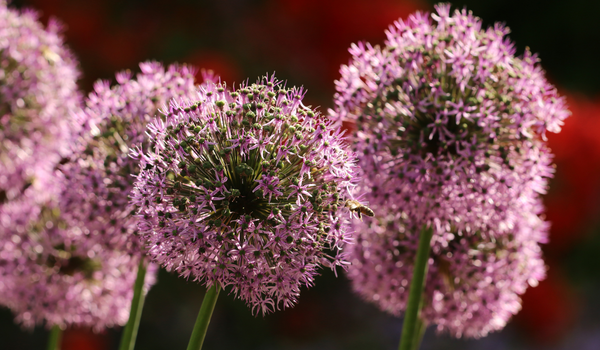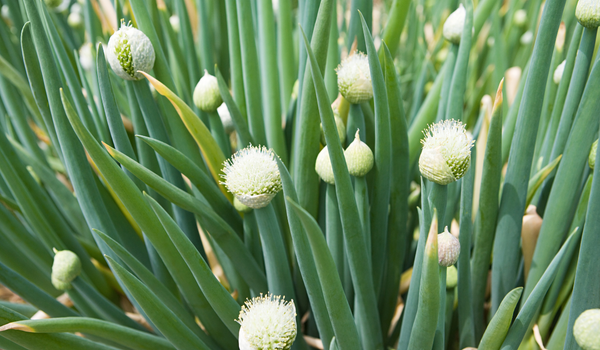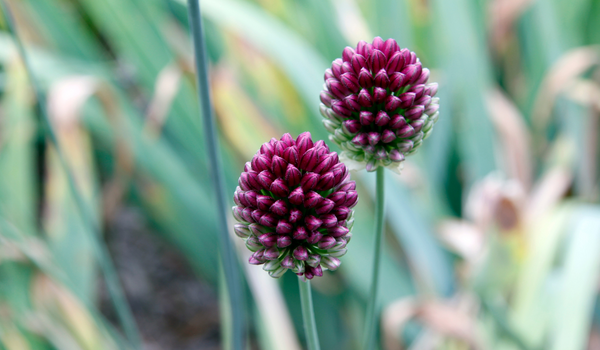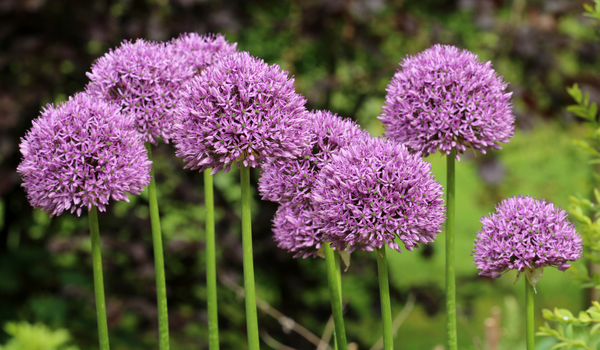The ultimate guide to planting, growing, and caring for your Alliums!
Whether you're a seasoned gardener or just starting your floral journey, this comprehensive guide will illuminate the path to successfully planting, growing, and nurturing your Allium bulbs. From the optimal planting times in the fall to the art of deadheading for prolonged blooms, we'll delve into every facet of Allium care. Discover the magic of these stunning flowers as we explore the intricacies of their bloom periods, the choice between pots and the ground, and the nuances of providing them with the ideal care they deserve. Let's embark on a floral adventure together!
How to plant Allium bulbs?
To ensure thriving Allium bulbs, select a well-draining site receiving ample sunlight. Plant bulbs in the fall, about 2-3 times their width deep, typically 6-8 inches apart, in a group or individually. Loosen the soil and add organic matter for improved drainage. Position bulbs with their pointed ends upward, covering them gently with soil. Water thoroughly post-planting to settle the soil. Alliums favor slightly alkaline soil and require minimal maintenance. Provide consistent moisture during their growth period, then allow the soil to dry out during dormancy. Mulching can regulate soil temperature. With these steps, your Allium bulbs can flourish vibrantly.

Optimal timing for planting Alliums in Fall
For optimal growth, plant Allium bulbs in the fall, ideally about 6 to 8 weeks before the ground freezes in your region. Fall planting, typically between September and November, allows the bulbs to establish roots before winter dormancy, ensuring a robust start in the spring. Choose a well-draining location with full sun exposure to foster healthy growth. Plant the bulbs at a depth of approximately three times their diameter, ensuring good soil contact to prevent rotting. Incorporate organic matter like compost for added nutrients. Timing your Allium bulb planting in the fall sets the stage for vibrant blooms in the following spring.
Should Allium bulbs be soaked before planting?
Preparing Allium bulbs for planting does not require soaking. Alliums prefer well-draining soil and excessive moisture can lead to bulb rot. These bulbs are generally resilient and soaking them is unnecessary. Instead, ensure the planting site is in a sunny area with good drainage. Plant the bulbs in the fall, about 2-3 times the depth of the bulb itself, with the pointed end facing upwards. Water the bulbs after planting to settle the soil but avoid overwatering. This approach helps Allium bulbs establish strong root systems and thrive, without the need for pre-soaking, promoting healthy growth and vibrant blooms.
Where to plant Alliums for maximum impact
To create stunning visual impact, plant Allium bulbs in areas with well-draining soil and ample sunlight. These striking ornamentals thrive when placed in strategic locations such as borders, rock gardens, or mixed with perennial beds. For a dramatic effect, consider planting them in clusters or drifts to enhance their eye-catching spherical blooms. Alliums complement various garden styles and look exceptional when used as focal points or as part of a diverse flower arrangement. Their tall stalks make them ideal for the backdrop of flower beds, while their vibrant hues add a pop of color to any landscape, ensuring a captivating display.

Pots vs. ground
When considering where to plant Allium bulbs, both pots and the ground offer unique advantages. Pots provide flexibility, allowing for easy mobility and control over soil conditions. Opt for well-draining soil and a pot deep enough to accommodate bulb growth. Ground planting, however, grants natural soil expansion, enabling larger plant growth and potentially increased flowering. Prioritize well-drained soil and adequate sunlight for successful ground planting. While pots suit smaller spaces and permit better control, ground planting offers natural growth benefits. Ultimately, the choice between pots and ground depends on available space, desired growth size, and the level of control preferred for nurturing Allium bulbs.
How to grow Alliums?
Growing Alliums, such as ornamental onions, is a rewarding experience. Plant them in well-drained soil, ideally in a sunny spot, during the fall for spring blooms. Dig a hole two to three times deeper than the bulb's height and space them around 6 inches apart, ensuring the pointed end faces up. Cover with soil and water thoroughly. These hardy perennials don't demand much maintenance but benefit from occasional watering during dry spells. After flowering, let the foliage naturally wither to nourish the bulb for the next season. Alliums thrive in USDA Zones 3-9, offering stunning globes of color to gardens, and are excellent for attracting pollinators.
Allium bloom period: what to expect
Allium bulbs offer a diverse bloom period. Generally, these captivating blooms emerge in late spring to early summer, typically between May and July, depending on the species and environmental conditions. They showcase spherical or star-shaped flowers atop sturdy stems, presenting vibrant hues of purple, pink, white, and blue, enhancing garden landscapes. The bloom duration typically spans two to three weeks, offering a delightful spectacle. To maximize enjoyment, stagger planting times and select different Allium species, ensuring a prolonged flowering season that enchants garden enthusiasts with their unique shapes, sizes, and colors.

Ensuring continuous blooms of Alliums
To ensure a continuous burst of blooms from your Allium bulbs, consider staggering your planting times. Alliums thrive in well-draining soil and prefer sunny locations. Plant bulbs in the fall, setting them approximately 3 times as deep as the bulb's height. To prolong flowering, choose different Allium varieties with varied bloom times, ensuring a sequential display of colors and shapes throughout the season. Deadhead spent flowers to encourage additional blooms and prevent seed formation, redirecting the plant's energy towards bulb growth. Regular watering during dry spells and a balanced fertilizer in early spring can support vigorous growth and persistent flowering, ensuring a captivating and prolonged Allium display in your garden.
The importance of deadheading Alliums
Deadheading Alliums, the process of removing spent flower heads, is crucial for their health and aesthetics. By snipping off faded blooms before they set seeds, energy is redirected from seed production to bulb development, enhancing next season's growth. This practice also prevents self-seeding, which could lead to overcrowding. Furthermore, deadheading encourages the plant to focus on nourishing the bulb, promoting stronger roots and larger blooms in subsequent years. For gardeners, this means more prolific and vigorous displays of these striking flowers. Deadheading not only maintains the plant's vitality but also extends the beauty and lifespan of Alliums in your garden.
Duration of Allium blooms: a timeline
Allium blooms showcase a fascinating timeline, varying in duration based on the specific variety planted. Typically, these striking ornamental onions bloom in spring or early summer, starting as early as late spring and lasting through early summer, with bloom periods spanning approximately 1-3 weeks. However, the flowering duration can be influenced by factors like the Allium species, environmental conditions, and geographic location. For instance, larger Allium varieties might boast a longer blooming period than smaller ones. Gardeners can anticipate and enjoy the vibrant display of Allium blooms in their gardens during this delightful seasonal window.

Number of blooms from one Allium bulb
Typically, each Allium bulb produces a single vibrant and spherical flower. This primary bloom, while consisting of numerous tiny flowers, emerges from a solitary bulb. As the Allium matures over time, it has the exceptional capacity to multiply, yielding more bulbs that will, in turn, result in additional blooms. While each bulb initially yields one striking flower, the beauty of Allium lies in its ability to proliferate and create more flowering bulbs, offering an ever-expanding display of its distinctive and captivating blooms in your garden.
How to care for Alliums?
Alliums require minimal care for stunning results. Plant bulbs in well-draining soil, ensuring a depth approximately three times the bulb's diameter. These hardy perennials thrive in full sun and prefer soil with good drainage to prevent waterlogging, which can cause bulb rot. Once planted, water moderately during the growing season, allowing the soil to dry between waterings. Deadheading spent flowers promotes continuous blooming and prevents self-seeding. Apply a balanced fertilizer in spring to encourage healthy growth. After flowering, allow the foliage to wither naturally to nourish the bulb for the next season. With these simple steps, your Alliums will flourish year after year.
Winterizing Alliums: can you leave them in the ground?
Winterizing Alliums requires some consideration. Allium bulbs are generally hardy and can withstand cold temperatures. In most regions, you can leave Allium bulbs in the ground throughout winter. However, in areas with extremely harsh winters or excessive moisture, it might be advisable to lift and store them. To ensure their survival, consider a protective layer of mulch to insulate the bulbs during frosty weather. This mulch can safeguard against freeze-thaw cycles and temperature fluctuations that may damage the bulbs. For added protection, monitor the soil's drainage to prevent waterlogging, which could potentially rot the bulbs. Ultimately, understanding your local climate is key to deciding whether to leave Allium bulbs in the ground during winter.

Do Alliums come back every year?
Alliums are perennial bulbs, which means they return and bloom year after year. These striking flowering bulbs typically reappear annually without the need for replanting, making them a low-maintenance addition to gardens. Once planted in well-draining soil during the fall season, these hardy bulbs establish strong root systems before winter sets in. They endure colder climates exceptionally well and often thrive in various soil types and sun conditions. With proper care, such as adequate watering and occasional fertilization, Alliums can reliably re-emerge, delighting with their unique spherical blooms and vibrant colors, bringing joy to your garden each spring and summer.
Timing is everything: when to cut back alliums?
Timing plays a crucial role in maintaining the vibrant allure of alliums. Once these enchanting flowers have bloomed and begun to fade, it's recommended to wait until the flower heads have dried and withered before cutting them back. This typically occurs in late summer or early fall, depending on your location and the specific variety. By allowing the alliums to complete their natural cycle and the seed heads to dry, you'll ensure the bulb has absorbed the nutrients necessary for next year's growth. After the heads have dried, you can gently snip the stems at ground level, preserving the plant's vitality and encouraging a spectacular display in the following season.
The perfect fertilizer recipe for Alliums
For vibrant and healthy Alliums, a balanced fertilizer is crucial. Use a granular or liquid fertilizer with an N-P-K ratio (nitrogen, phosphorus, potassium) of around 5-10-10 or 10-10-10 to support their growth. A slow-release fertilizer applied during the planting phase or early spring aids in establishing strong roots. For established plants, a second application after blooming encourages bulb development. Organic options like compost or well-decomposed manure provide a natural nutrient boost. Remember, moderation is key; avoid excessive nitrogen that might encourage foliage growth at the expense of flower formation.
Share
